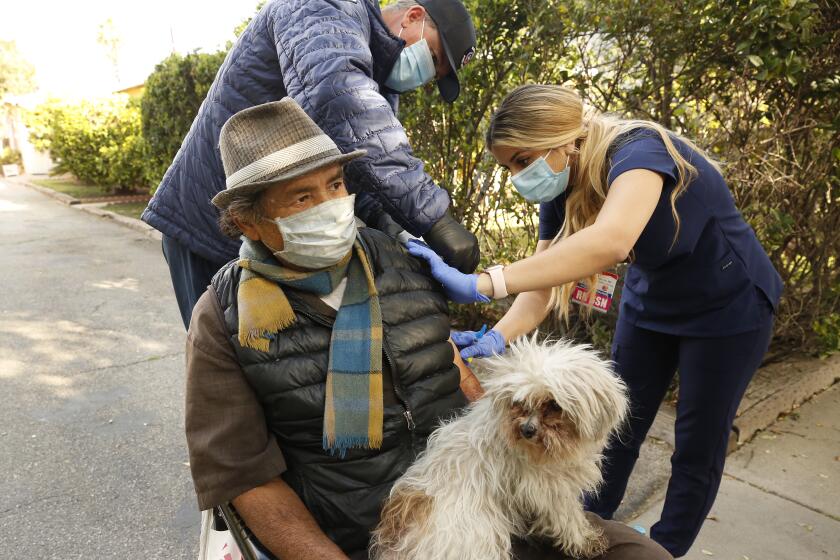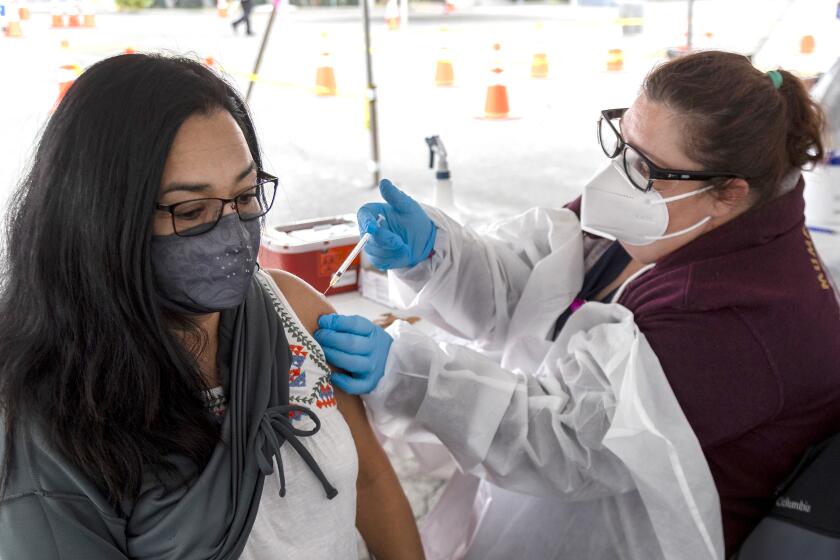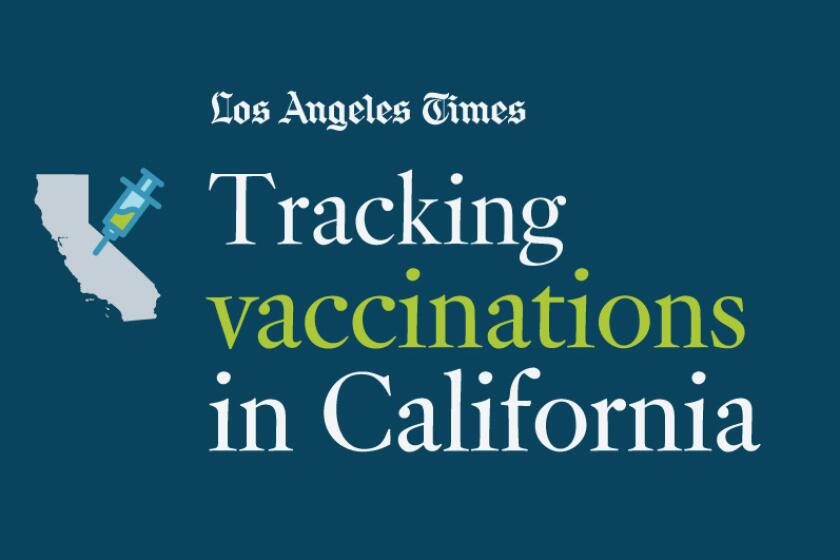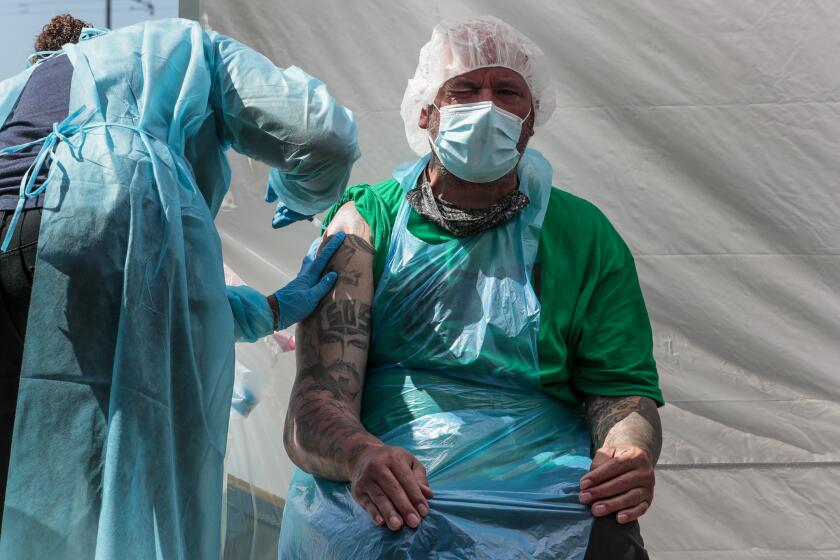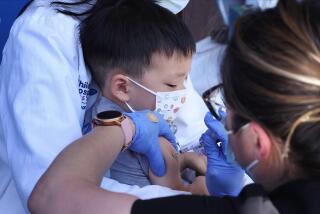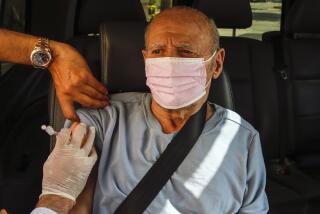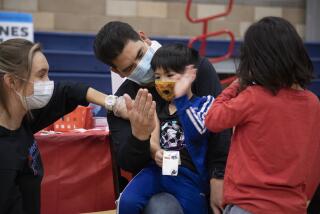Here’s how Californians who aren’t vaccine-eligible are getting it anyway. Without cheating
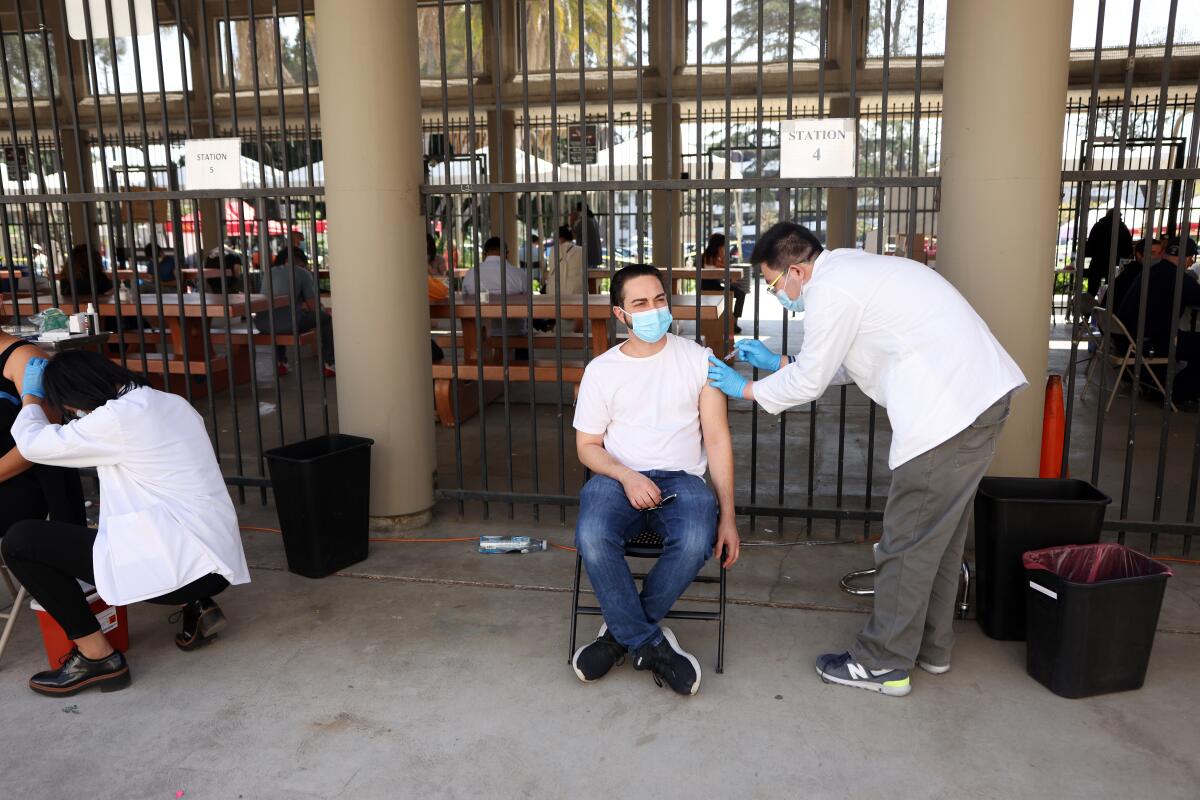
- Share via
California won’t officially open eligibility for the COVID-19 vaccine to all adults until April 15.
But as supplies of the vaccine have increased recently — a trend state officials are optimistic will continue in the coming weeks — some parts of California now have periodic excess. And that is leading officials to make doses available to all adults, even those not eligible under current rules.
That occurred this week in several places, including Riverside County, Bakersfield, the Bay Area and even parts of Los Angeles. But those extra slots have been filled quickly, leading some to be turned away.
California sees huge regional variations in COVID-19 vaccination rates for people 65 and older
Here is what we know:
Can anyone get a shot?
Vaccines remain hard to get for some, even those 50 and older who are officially eligible. But in some parts of the state, access is being thrown open.
That’s been the case at Cal State Los Angeles. Eligible people have failed to claim thousands of appointments at the vaccination site through the MyTurn registration system. As a result, vaccinators have been allowed to inoculate adults walking up to the site without an appointment — including people who don’t qualify under the current eligibility criteria, said Brian Ferguson, a spokesman with the state Office of Emergency Services.
Anyone 18 and older will be allowed to wait in line to get a shot at the Cal State L.A. site through Sunday night, Ferguson said.
“As long as vaccines remain available, we’ll vaccinate until we’re out,” he said.
Those hoping for a vaccine should note that, as a result of word-of-mouth, the site has quickly been flooded with walk-ins. On Thursday morning, so many hopefuls lined up that extra doses ran out and people were turned away.
The vaccination site for the young from Los Angeles County is a Cal State Bakersfield facility that has more doses than patients and no restrictions.
Does this affect those who have priority and an appointment?
No.
Vaccinators will still prioritize appointments made through the state’s My Turn system, which can only be made by people age 50 and over, those with underlying medical conditions, and people who work in specified essential fields, such as healthcare, education, childcare, emergency services, and food and agriculture.
People can sign up for an appointment at the My Turn website or by calling (833) 422-4255.
The move will make COVID-19 vaccines available to hundreds of thousands of additional Californians in counties across the state.
Where else in California has vaccine eligibility eased?
Other counties have decided to move faster than advised by the state to allow all adults and some teenagers access to the vaccine.
In Southern California, Kern, Riverside and San Bernardino counties have made anyone 16 and older eligible to get a shot.
Orange County is allowing anyone 16 and older who lives in four ZIP Codes hard-hit by the COVID-19 pandemic — 92701 and 92703 in Santa Ana, 92805 in Anaheim and 92844 in Garden Grove — to be vaccinated.
In the Bay Area, Alameda County is allowing anyone 16 and older living in a dozen hard-hit ZIP Codes to be vaccinated, including in neighborhoods in Oakland, Hayward, San Leandro and unincorporated San Lorenzo.
Elsewhere in California, a number of counties in the north — such as Contra Costa, Butte, Shasta and Nevada — are among those that have opened up vaccines to those ages 16 and over; most require recipients to either live or work in those counties. Yuba and Sutter counties have made COVID-19 shots available to anyone 18 and older who lives or works there.
The UC Davis Health system in the Sacramento area is also vaccinating people 16 and older.
All COVID-19 vaccines are free for anyone living in the U.S., regardless of immigration or health insurance status.
Long Beach announced Thursday that it too will begin vaccinating all people 16 and up as walk-ups at the Long Beach Convention Center, which operates Monday through Saturday.
Experts say about most Americans will need to be vaccinated to bring the coronavirus pandemic under control. Track California’s progress toward that goal.
Why are the rules loosening up?
Officials in Kern County attributed the change in policy to an increase in supplies and a slowing of vaccine appointments.
Kern County resident Natalie Frieson, 24, said the expansion was a welcome change.
“It means we can get back to a normal society much sooner,” she said, “and hopefully less vaccines will expire.”
Appointments are available at the Kern County Fairgrounds mass vaccination site this week, officials said, and can be booked through the state’s My Turn system.
“I’m very relieved,” Frieson added, “to know that our public health officials realized that we were able to expand the eligibility before the state’s date of April 15 when they could have decided to just wait the extra week.”
Officials in Riverside, one of California’s largest counties, attributed their expansion to an increase in supplies. Last week, the county administered its 1-millionth dose of the COVID-19 vaccine.
“More vaccine is available now, and opening eligibility will move us even further toward our goal of vaccinating the majority of our residents,” said Karen Spiegel, the county’s 2nd District supervisor. “Vaccine works best when the majority of the population takes it.”
Two COVID-19 vaccines are likely to be protective against a rapidly spreading variant of the SARS-Cov-2 virus that arose in California, a study finds.
Will there be enough supply?
California’s planned full reopening two months from now is riding on it.
“With the expectation of an abundance of doses coming in from the federal government through the end of this month and into May,” Gov. Gavin Newsom said Tuesday, “we can confidently say by June 15 that we can start to open up as business as usual — subject to ongoing mask wearing and ongoing vigilance.”
Recently released federal data, however, are raising new questions as to whether supply will match the rosy expectations.
Although California’s allocations of the Pfizer-BioNTech and Moderna vaccines are expected to remain relatively steady through next week, the state — along with the rest of the nation — will see availability crater for the single-shot Johnson & Johnson vaccine.
This week, 574,900 Johnson & Johnson doses were allocated to the Golden State. Next week, that number will plummet to 67,600, an 88% drop, according to data from the CDC.
The allocation is expected to drop even further the week of April 18, to 22,400, according to the California Department of Public Health.
“To put this into perspective, the supply projections for the next two weeks are approximately what the state received in the second half of March,” department spokesman Darrel Ng wrote in an email Thursday.
This nosedive for Johnson & Johnson will drive down the size of the state’s federal allocation from the 2.4 million doses received this week, to 2 million next week and 1.9 million the week after that.
However, Ng pointed out that “there are multiple vaccine supply streams coming into the state.” The direct state allocation accounts for about 70% of the total, with the remainder flowing straight from the federal government to pharmacies, health centers and other qualified entities.
It’s unclear how long it will take to reverse the drop in supply. Regardless, Ng said California will expand eligibility as planned next week.
Newsom acknowledged earlier this week that supply of the Johnson & Johnson vaccine remained uncertain, but he said he was hopeful for more stability.
“We have lots of confidence in the medium run and long run,” he said, “meaning the short-term with J&J variability begins to give way to more confidence in May,” with expectation that the vaccine “will substantially come in at a much higher and more predictable number.”
The availability — or lack thereof — of the Johnson & Johnson vaccine isn’t a problem only for California. Nationwide allocations are set to tumble from nearly 5 million this week to 700,000 next week.
Rollout of the Johnson & Johnson vaccine has been inconsistent and dogged by production issues. Last week, the company said a batch of vaccine had failed quality standards and couldn’t be used. The drugmaker didn’t reveal how many doses were affected, though news reports pegged the number at 15 million.
To date, providers throughout California have doled out nearly 20.9 million COVID-19 vaccine doses, and 35.1% of residents have received at least one shot, according to data from the Centers for Disease Control and Prevention.
Roughly 18.8% of Californians are fully vaccinated, meaning they’ve either received the single-shot Johnson & Johnson vaccine or both required doses of the Pfizer-BioNTech or Moderna vaccine.
Nationwide, 33.1% of Americans have received at least one dose, and 19.4% are fully vaccinated, CDC data show.
During the early phases of the vaccine rollout, California restricted access to the shots to those considered at highest risk from COVID-19, either because of their age, occupation or underlying health conditions.
President Biden had initially said states should make all adults eligible for COVID-19 vaccines by May 1. But he announced a more aggressive timeline — setting a deadline of April 19.
More to Read
Sign up for Essential California
The most important California stories and recommendations in your inbox every morning.
You may occasionally receive promotional content from the Los Angeles Times.
